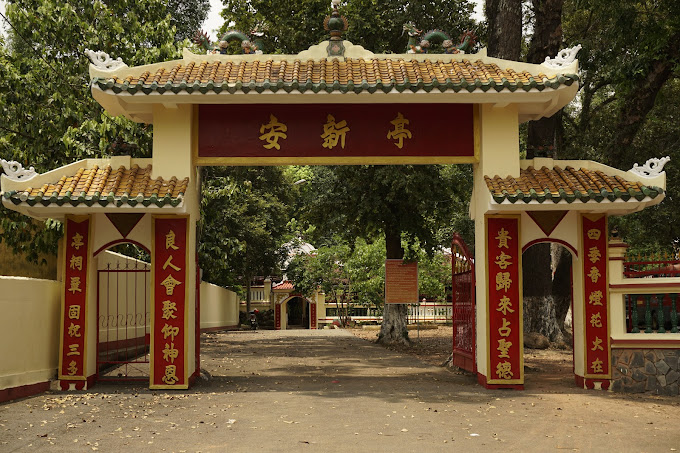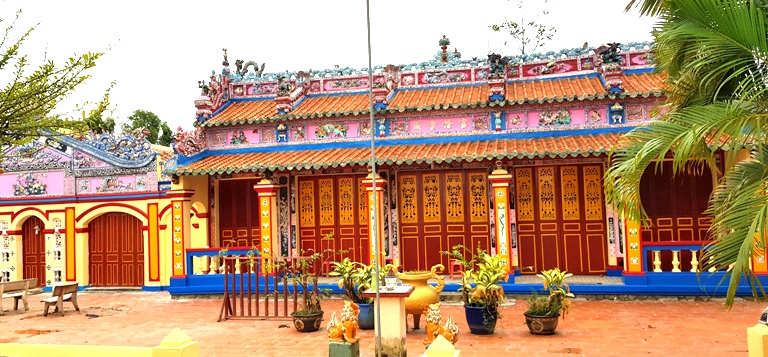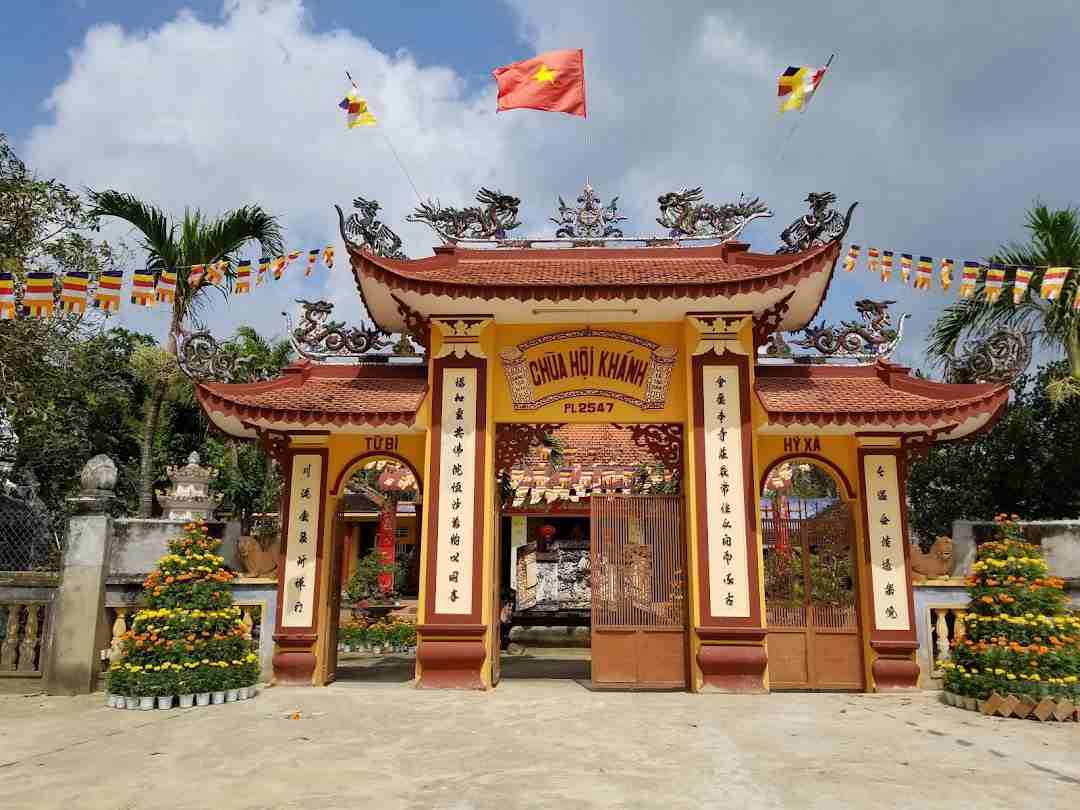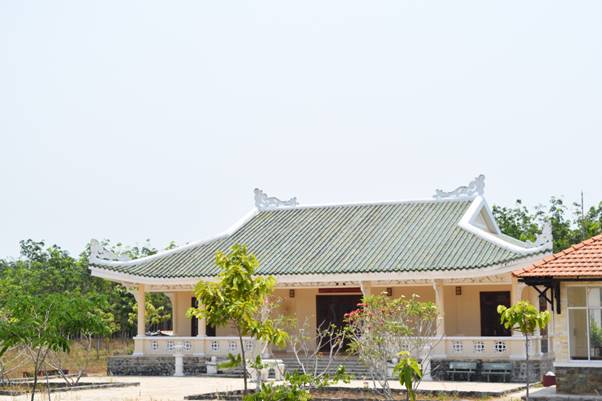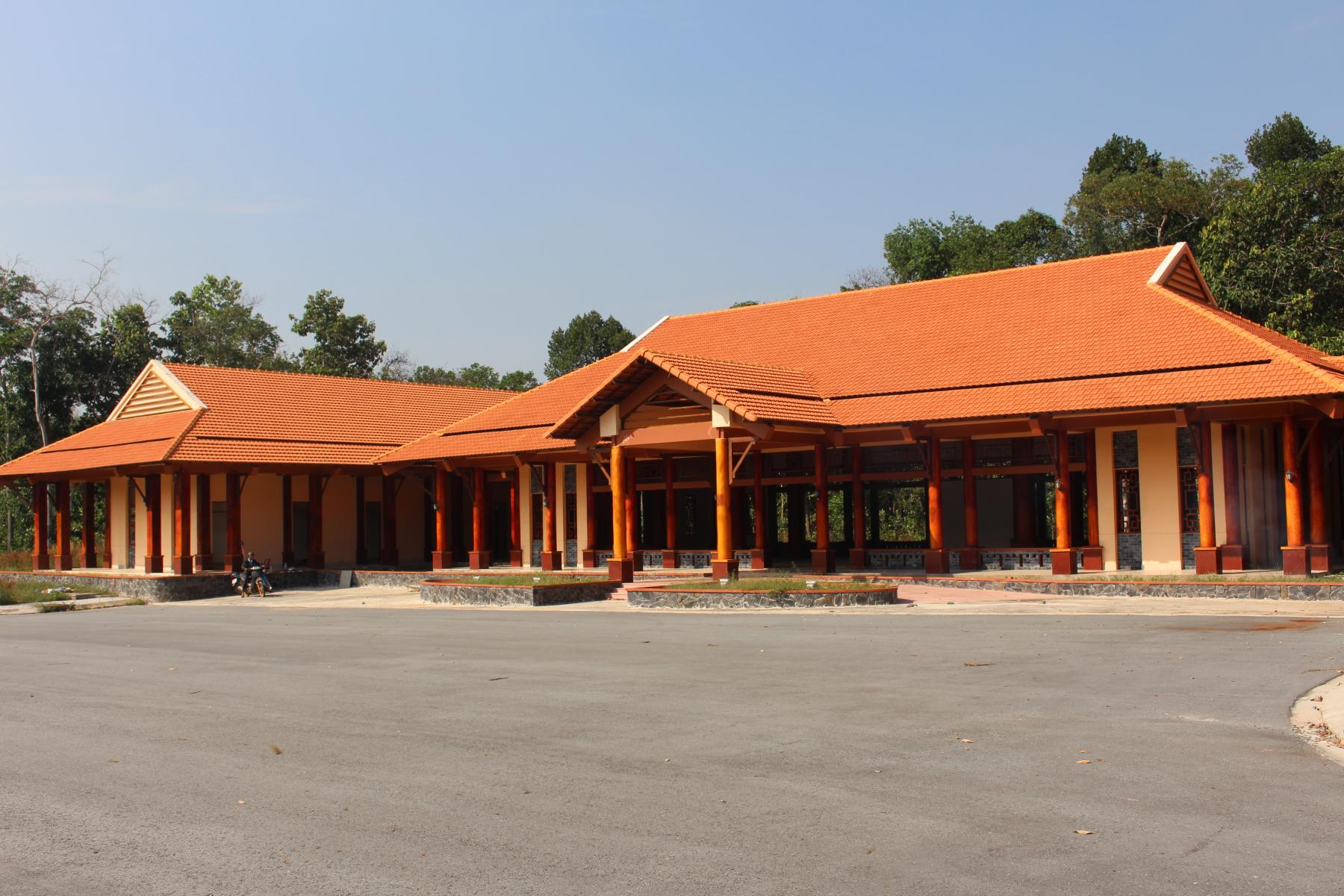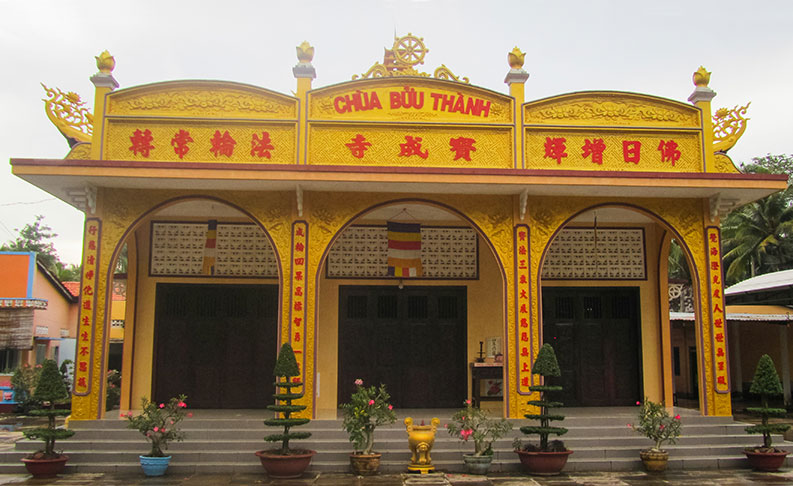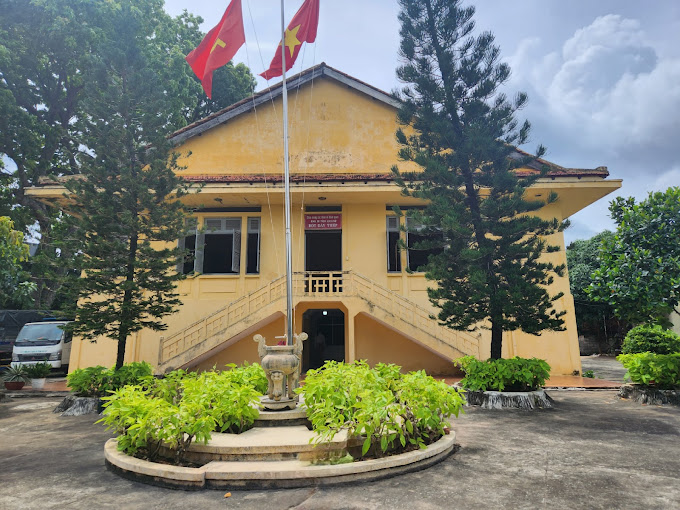Relic point Vietnam
Việt NamTan An Communal House
Tan An Communal House - Ben The is located in Quarter 1, Tan An Ward, Thu Dau Mot City. This is a provincial-level historical and cultural relic ranked on June 2, 2004. On April 26, 2014, Tan An Communal House was recognized by the Ministry of Culture, Sports and Tourism as a National Architectural and Artistic Monument. The communal house was built in 1820 by the first class of residents who came to this land to make a living. Initially, it was built as a few simple thatched houses, so it was named "Tuong An Temple", by the people of 4 communes: Tuong Binh (now Tuong Binh Hiep), Tuong An (now Tan An), Tuong Hoa (now Dinh Hoa) and Cau Dinh (now Tan Dinh) were established to worship the god Thanh Hoang Bon Canh, the communal house is located in Tuong An village. About 30 years later, the ancestors of the Nguyen family (who held the position of Board of Examiners) took charge of rebuilding the communal house on a large scale, taking on the shape it has today. On the other hand, the Nguyen family was one of the first classes of residents to come to Tan An land to reclaim land to settle down and had the merit of restoring the village communal house, so they were honored by the villagers as "Previous Sages - Later Sages" and worshiped in the temple. main hall to pay respect. On November 19, the 21st year of Tu Duc's reign (1869), King Tu Duc ordained Tan An communal house to recognize the communal house and confer the title of Thanh Hoang god so that people could know and worship. The ordination is always kept at the Nguyen family church (currently Mr. Nguyen Tri Quan's house). According to the decree given by King Tu Duc, the main deity worshiped in the communal house is Tien Quan Co Nguyen Van Thanh, a royal official of the Nguyen Dynasty, a great mandarin of King Gia Long. Nguyen Van Thanh was a founding father of the Nguyen Dynasty, but was entangled in the "literary" case of his son Nguyen Van Thuyen, was suspected of treason by Gia Long, was forced to death, and was only exonerated more than half a century later. there (in 1868). Regarding the architectural overview, the communal house is made entirely of Sao wood, has a Tam-shaped architectural style, also known as the Doi Doi style, folk called the three-roof communal house, in the style of Xuyen Dinh, two roofs, two wings, including 40 square wooden pillars, wide hallway with 30 wooden pillars (due to the rain and sun, some pillars on both sides of the hallway were damaged, so they were replaced with pillars made of bricks and lime). The communal house's roof is covered entirely with fish fin tiles that have been covered with moss over many years of rain and sun, looking very ancient. The communal house is decorated with images of two dragons and pearl paintings, and at the corners of the roof are decorated with images of fish turning into dragons. The floor is tiled with hexagonal red tiles (Chinese tiles). The entire communal house is 50m wide and 70m long, built on an area of more than 10,000m2. In particular, the entire interior of the communal house such as altar artifacts, altar cabinets, diaphragms, bamboo panels, wooden pillars, couplets... are all made of precious wood, delicately carved by artisans with many different themes. enhances the unique artistic architecture of the communal house. In addition, the communal house also stores a very rich Chinese writing that remains to this day through pairs of parallel tureens, horizontal panels, and deities... Every year, according to ancient rules, the festival takes place for 3 days and 3 nights from November 14 to 16 (lunar calendar), a bright moon occasion for people to conveniently have fun and travel. This is also the occasion for high tides and according to people's beliefs, it is a sign of a good harvest, good things, and abundant money... Tan An communal house is a historical - cultural relic with bold architectural, artistic and scenic features. In particular, the communal house also preserves the decree of King Tu Duc. During the years of resistance against foreign invaders, Tan An communal house was a place of local revolutionary activities. Source: Binh Duong Electronic Newspaper
Ho Chi Minh City 3509 view
Phu Long Temple
Phu Long communal house, also known as "Phu Long spiritual temple", is located in Hoa Long quarter, Lai Thieu ward, Thuan An city, was ordained in the 5th year of Tu Duc and recognized as a Historical - Cultural Monument. national level in 2001. After nearly 200 years, despite many restorations, the architecture and valuable artifacts are still preserved at the communal house. The communal house was built by local people to worship the god Thanh Hoang Bon Canh. At first, the communal house was built of bamboo and wood on a rough ground. After that, the communal house was restored many times in 1865, 1935, 1997... Currently, the communal house has a total usable area of 5,828m2, construction area of 1,258m2. The communal house was built in a three-letter style, in the style of "coincide to the sky", roofed with yin and yang tiles, and floor lined with floral tiles. The communal house's gates, vertical and horizontal walls are carved with patterns and motifs, most of which are meticulously decorated with pieces of ancient porcelain enamel, colorful, rich with many diverse images and legends, with unique nuances. Enemies of harmonious natural water areas. Regarding architecture, the entire facade and concrete part of the communal house are covered with colorful ceramic pieces, creating the unique beauty of traditional ceramic art in the architecture of communal houses and pagodas in Thu Dau Mot. The entire electricity bill has wooden panels carved with fruit themes such as apricot, orchids, chrysanthemums, pomegranates, grapes, and bananas, symbolizing fertility and proliferation. In the space between the central hall and the main hall, there is a blue glazed ceramic panel, decorated with images of dragons, unicorns, scenes of the Eight Immortals, Long Hai generals, fish turning into dragons... On the roof of the central hall, in the middle there is a sun and moon shape, the gables are shaped like dragons, unicorns, turtles and phoenixes. The roof of the back hall also has patterns of fish turning into dragons and two dragons painting pearls. Inside the roof of the central hall and back hall are two sets of wooden load-bearing trusses, structured in a striped pattern, two rows of columns consisting of six wooden trees, with a diameter of 40cm. In the middle of the main hall is an altar worshiping the deity Thanh Hoang Bon Canh given by King Tu Duc, on both sides worshiping Ta Ban and Huu Ban. Here, people who have contributed to the village are also worshiped, with the communal house in order, each altar has a tablet. Particularly, the highest altar is in the shape of a square wooden chair, carved with images of apricot, orchid, chrysanthemum, and bamboo, with embossed dragon leaves looking very majestic (called Ngu). The main hall has many incense burners arranged in an orderly manner for visitors from all over to burn incense and worship to show their respect. Next to the incense burner are a pair of tortoises and cranes standing in adoration, symbolizing sustainability. On the gable end, on the left is the Ngu Hanh Nuong Nuong altar, next to it is a 1.8m long snare, on the right is the altar of Mr. Ho, next to it is a drum for use in worship and festivals. The altars of Before Hien and Later Hien are also solemnly decorated. Looking straight into the main hall from the outside, there is a row of ceremonies, including many types of weapons with four pairs of cranes standing on the backs of turtles. The communal house still retains many parallel sentences engraved on the pillars, incense burners..., all of which are intricately carved and brilliantly gilded. Decorative patterns inside and outside the communal house include fish transforming into dragons, stylized dragons, scenes of the Eight Immortals... In addition to its artistic architectural values, Phu Long Communal House was once a place of refuge and weapons for many generations of local revolutionary officers and soldiers during the two resistance wars against the French and Americans. Source: Binh Duong Province Tourism Promotion Center
Ho Chi Minh City 3344 view
Hoi Khanh Pagoda
Hoi Khanh Pagoda is located at 35 Yersin Street, Phu Cuong Ward, Thu Dau Mot City, is the largest religious and artistic architectural work in the province, recognized as a National Historical-Cultural Monument on September 7. January 1993. The pagoda was built in the 18th century (1741), at the foot of the hill, 500m east of Thu Dau Mot city center. In 1861, the pagoda was destroyed by the French invaders. In 1868, the pagoda was rebuilt at its current location with a construction area of 1,211 square meters. In 2007, the pagoda built a 27m high 7-storey tower and recreated the "Four Hearts" Buddhist site, including: Lumbini Garden (where Buddha was born), Bodhi Dai Trang (where Buddha practiced Buddhism), Deer Park (the place where Buddha first preached) and Ta La Song Tho (Buddha's nirvana) have profound meanings about the Dharma. In 2008, a large-scale, 22m high Buddha stand was built in the land in front of the pagoda. The ground floor is a row of buildings 64m long, 23m wide used as a Buddhist School, Library... The upper floor is decorated with a statue of Master Shakyamuni entering Nirvana, 12m high, 52m long. This is a proud fine art work of Binh Duong Buddhism, solemnly inaugurated on March 30, 2010 (February 15, 2010 lunar calendar) to celebrate 1,000 years of Thang Long - Hanoi. The structure of the pagoda consists of four main parts: The front hall - the main hall, this architectural lecture hall has 92 precious wooden columns, the East and West corridors of the pagoda are arranged in a "paired" style, connected to each other with an "overlapping terrace" architecture. "duong luong" - this is a special variation in architecture following the ancient pagoda tradition of Cochinchina; The main hall with pillars, wooden walls and three sets of curtain doors, also has nearly 100 wooden statues, Arhats and ten Minh Vuong palaces with different shapes made of jackfruit wood painted with gold and lacquer. In particular, there are two reliefs carved with images of 18 Arhats and Bodhisattvas, creating a beautiful sculpture with high artistic value typical of the ancient Binh Duong wood carving style. Regarding interior decoration art, worship statues are sculpted and carved very elaborately and sharply... especially the set of "Thap Eight Arhats" (created in 1921), the painting "Four times" reliefs cover the two columns in front of the main hall. The elaborately carved altars were completed in the year of At Suu (1925). The pagoda still retains a set of woodblocks printed on sutras from over 120 years ago. The pagoda's great bell was cast in the year of the Goat (1883) and donated by Buddhist monk Duong Van Lua. During the years 1923 - 1926, Hoi Khanh Pagoda was also a place of refuge for notables: Confucian scholars and patriotic monks jointly established the "Honorary Society" with the participation of Venerable Tu Van, Vice President Nguyen. Sinh Sac (Uncle Ho's father), Mr. Tu Cuc... the Association's purpose is to promote a lifestyle that upholds morality, respects honor and love for fellow countrymen. Although the Association only operated for a short time, it made a significant impact. After the August Revolution of 1945, Hoi Khanh Pagoda was the headquarters of the Buddhist Association for National Salvation in Thu Dau Mot province, contributing a lot of effort, enthusiasm, and blood of the monks and Buddhists of the pagoda. During the local people's resistance war against foreign invaders since 1953, the pagoda was the headquarters of patriotic Buddhism in Binh Duong province and in 1983, Hoi Khanh Pagoda was the headquarters of the Binh Duong Buddhist Association. In 1995, here, the Provincial Association built the Basic Buddhist School of Song Be province (Binh Duong). Currently, Venerable Thich Hue Thong is the abbot of Hoi Khanh Pagoda (since 1988) and is the Standing Deputy Head of the Binh Duong Buddhist Association. Source: Binh Duong Province Electronic Information Portal
Ho Chi Minh City 3393 view
Ho Chi Minh campaign forward command post
The Ho Chi Minh Campaign Front Command Relic is located in hamlet 1, Minh Tan commune (formerly Minh Thanh commune), Dau Tieng district, Binh Duong province (the location was also determined by General Van Tien Dung in 1987). The relic was ranked as a national revolutionary historical relic by the Ministry of Culture, Sports and Tourism on May 11, 2010. The Ho Chi Minh Campaign Forward Command Relic is a typical relic, reflecting the correct, direct and creative leadership and command of the Central Department, the Regional Military Commission and the Campaign Command. Although the relic is a temporary agency, it has demonstrated a correct and wise leadership role in the war strategy of the new era, which is directly the historic Ho Chi Minh campaign. The reason it is called the Ho Chi Minh Campaign Forward Command Relic is because the Ho Chi Minh Campaign Command was established at the South Vietnam Liberation Army base in Ta Thiet Krom hamlet - Loc Thanh - Loc Ninh , Song Be. After the meeting on March 25, 1975 of the Politburo and Central Military Commission, according to the assignment of the Politburo, on the same day, comrade Le Duc Tho entered Loc Ninh to join comrades Pham Hung and Van Tien Dung. On behalf of the Politburo, directly directed the campaign to liberate Saigon. When the campaign was about to begin, in order to directly command the campaign from the beginning close to the agency's combat situation, the Ho Chi Minh Campaign Command was directly assigned by the Politburo, comrade Le Duc Tho, and co-comrade Le Duc Tho. Chief Van Tien Dung decided to move to the forward base closer to the battlefield and chose Cam Xe as the Cam Xe Command Post, also known as the forward command post of the Ho Chi Minh campaign. With this location that has been determined to be relocated, the Ho Chi Minh Campaign Forward Command Headquarters relic is one of the important locations that determines the correct and wise, direct, and agile direction to facilitate beneficial for the victory of our army and people in the historic Ho Chi Minh campaign. The Ho Chi Minh Campaign Forward Command has successfully completed the historic task assigned by the Politburo to liberate Saigon - Gia Dinh, liberate the South before the rainy season, successfully ending 30 years of fighting. complete revolution and armed uprising of our people in the fastest possible time. The relic is located in a forest area, there are many small and short streams flowing into the large Cam Xe stream such as Cac Lieu stream, Ong Lo stream, Bien Loc stream, Ba Gia stream, Ba Thanh stream... (Cam Xe according to calendar). The local history is a long-standing land, with a primeval forest with many types of precious trees, and next to this stream, with its powerful "martial" characteristics created many advantages for our army and people to expel the enemy in the two resistance wars against the French colonialists and the American imperialists). This is a regenerated forest, the old forest has been cut down, the regenerated forest has also been burned many times. Because the relic is a temporary institution, the camps and trenches here are mainly made of available wood materials. After a long period of destruction by rain and sun, only faint traces remain, only The bomb crater where comrade Van Tien Dung got water for daily use is still quite intact. According to the people living here, every March they burn it to grow cassava. Currently, the landscape of this area has changed a lot compared to before, vast rubber forests surround the relic area. The remaining traces such as: bomb craters for drinking water, traces of trenches are also faded, grass and trees grow quite a lot, it is very difficult to find old traces hidden by grass and trees. In 1987, General Van Tien Dung and a number of comrades from the region visited and determined the location based on the remaining traces. After that, the Binh Long district team and the people of Minh Thanh commune built a stele as a marker here. The stele is made of reinforced concrete, 3m high, 2.5m wide, on the stele is a star, under the star is written the words Ho Chi Minh Campaign Command, April 30, 1975, Minh Thanh commune. On August 20, 1990, Military Zone 7 Museum built another stele about 3m away from the old stele, 15m high, 1.5m wide, the stele was also made of reinforced concrete. In 2005, it was restored with marble until now. Source: Binh Duong province electronic information portal
Ho Chi Minh City 3487 view
War Zone D historical relic site
War Zone D was formed in February 1946 with the initial area including 5 communes: Tan Hoa, My Loc, Tan Tich, Thuong Lang, Lac An in Tan Uyen district, Bien Hoa province (now part of Tan Uyen Town). , Binh Duong Province). During each historical period of the resistance war against colonialism and imperialism, the scope of War Zone D changed. War Zone D is the code name for the headquarters of Zone 7, located in the system of areas of the zone in alphabetical order (A: Communications base, B: Logistics base, C: Area standing army). Later, the code name D was used to refer to the entire large war zone. In addition, there are a number of other explanations: D means "red", referring to the resilient revolutionary war zone, a "red address" of the whole country; D is the first letter of the place name Dat Cuoc - where Huynh Van Nghe's soldiers built their first base; D is the abbreviation for Dong Nai war zone, Eastern war zone, first war zone... Based on the original scope of 5 communes in Tan Uyen district, from 1948 onwards, War Zone D was expanded, taking Road 16 from the west and Dong Nai River from the south as the boundary to expand to the north. to Phuoc Hoa and east to Be River; then continue to cross the Be River and develop forever to the north and northeast. However, the main scope of the war zone lies on the land: To the west, it borders Road 16, from Tan Uyen town to Green Gate; The north borders Be River, the section from Phuoc Hoa bridge to Chanh Hung; The east still borders Be River, from Chanh Hung to Hieu Liem intersection, and the south borders Dong Nai river, from Hieu Liem intersection to Tan Uyen town. During the resistance war against the US, from the old war zone (mainly located in Tan Uyen area), we gradually moved the center of the base to the northeast. By early 1975, the base was completely built, with its maximum scope expanded. At that time, War Zone D was located within: The south bordered Dong Nai river; The west borders Binh Duong province and cuts through the two provinces of Phuoc Long and Binh Long (now Binh Phuoc); The north reaches far to the Vietnam - Cambodia border (section from Bu Dop to Bu Dang); The east borders Binh Thuan and Lam Dong provinces. War Zone D is considered a center of resistance, the birthplace of the armed forces of the Southeast region. During the resistance war against the French colonialists, War Zone D was one of the important bases of Party committees at all levels, government organizations and military command agencies in many neighboring districts, provinces and even Zone 7. , Eastern and Southern inter-regional division. This is also the birthplace of armed units in the early days of the resistance war, such as: Detachment 1, Detachment 10, Regiment 301, Regiment 310, Inter-Regiment 301 - 310, Main Battalion 303, Battalion transport convoy 320... During the resistance war against American imperialism, War Zone D was the place where the Party's leading agencies and the armed forces from districts, provinces, inter-provinces, military zones to Central China were built and stood. Central Department. War Zone D was the birthplace of the special forces fighting style, starting with the battle of the Ba Kien bridge watchtower in Tan Uyen on March 19, 1948, from which the special forces were formed, developing the special forces fighting style to the whole world. water. War Zone D is also a place associated with resounding victories of the troops and people of the Southeast region. In particular, this was the starting place of the 12-day and night campaign (from April 9 to April 21, 1975) to liberate Long Khanh town, smashing Xuan Loc steel door - the last line of defense of the Saigon puppet government. paving the way for the historic Ho Chi Minh campaign to win, completely liberate the South, and unify the country. Existing for nearly 30 years (1946-1975), War Zone D is a milestone in the heroic history of the "hard-working but heroic East". With the historical significance, stature and contribution of War Zone D through the two resistance wars against the French colonialists and the American imperialists, on May 11, 2010, the Ministry of Culture, Sports and Tourism ranked War Zone D is classified as a national historical relic. Source: Binh Duong Electronic Newspaper
Ho Chi Minh City 4972 view
Iron Triangle Tunnel historical site
Southwest Ben Cat Tunnels (Iron Triangle) is located on the land of 3 communes: An Dien, An Tay, Phu An in the southwest area of Ben Cat town, Binh Duong province. With its position and stature in the two resistance wars against invaders, the Southwest Ben Cat Tunnels were ranked by the Ministry of Culture, Sports and Tourism as a National Historical-Cultural Monument on March 18. /1996, with a total area of 230,000 square meters. During the previous resistance war against the French colonialists, the land of 3 southwest communes of Ben Cat was soon famous for the An Thanh War Zone. At that time, An Thanh was once the stopping place of the resistance headquarters of the Eastern Region, the Southern Party Committee, the Saigon - Gia Dinh Special Region Committee,... thanks to which the local people were soon enlightened. revolution and faced many of the fiercest challenges during the resistance war against the US to save the country, full of hardships and sacrifices of our people. In 1948, the first tunnel system appeared from this land. Then in 1960, Cu Chi guerrillas came to learn from experience and build a tunnel system in their locality. During the resistance war against America, the enemy attacked again and again, but they could not conquer the hearts of the people here. When the US imperialists massively sent expeditionary troops to directly fight in the South, in 1967, using all kinds of powerful soldiers and the most modern killing means, they launched a large-scale raid with 30,000 troops. , 400 tanks, 80 warships, 100 cannons and many types of bombers, including B52 aircraft to destroy this important target. But thanks to the winding and interlaced tunnel system, our army and people sometimes hide and sometimes appear secretly, suddenly launching a fierce counter-attack. In the end, the American enemy had to retreat. With the disastrous defeat, 3,200 American puppets were killed, 149 tanks and armored vehicles were destroyed, 28 planes were shot down, 2 warships were sunk and burned... In this battle, a hero emerged. sniper - Nguyen Van Duc, only 10 bullets killed 9 invaders or Vo Thi Huynh - hero of the armed forces who rolled under bombs and bullets to care for and protect wounded soldiers. After consecutive failures, the enemy was helpless, they had to call this area the "Iron Triangle" area. The Southwest Ben Cat Tunnels do not simply have a geographical meaning but are a symbol of revolution and resistance. With the rudimentary means of a hoe blade and a bamboo shovel, the soldiers and people of the three communes created a massive project with hundreds of horizontal and vertical tunnels underground, connecting the communes together like a "Village". implicit". Every family in the belt area dug tunnels and trenches connected to the tunnels, creating a continuous position to both maintain production and fight the enemy to protect the village. Connected to the tunnels, there are large tunnels for resting after battle, places to store weapons, food, drinking water, wells, cooking tunnels, working tunnels, command tunnels, and wounded nursing tunnels. soldiers. The Southwest Ben Cat Tunnels with their activities played a particularly important role in the two resistance wars, especially during the period of resistance against the Americans to save the country. During the 20-year war against the American imperialist invasion, the Southwest Ben Cat Tunnels promoted the effect of a war tunnel. Relying on the tunnel system, the soldiers and civilians of the three Southwest communes fought to bury thousands of enemies, fire and destroy hundreds of tanks and armored vehicles... Especially during the 1968 Mau Than campaign and the spring of 1975. , Southwest Tunnels is where many large armies gathered from here to attack Saigon, contributing to the victorious resistance cause of the country's army and people in 1975. Source: Binh Duong province electronic information portal
Ho Chi Minh City 3720 view
Phu Loi Prison Relics
Phu Loi Prison Relics is located on Mot Thang Twelf Street, Phu Loi Ward, Thu Dau Mot Town. The current total area is 77,082m2, and was recognized by the state and ranked as a national historical relic on July 10, 1980. Existed for eight years (1957-1964). But with an indomitable spirit of resilience, Phu Loi prisoners united and fought heroically to victory. With the plot to invade the South, using demagoguery and terrorism to the campaign of "denouncing communism" and "destroying communism" within just 2-3 years after the Geneva Agreement, My Diem caused countless incidents. Many crimes throughout the South. By saying "it's better to catch a wrong person than miss one", they have built more prisons. Phu Loi Prison is one of the major US-Diem prisons in the South, built in mid-1957 to imprison and torture revolutionary soldiers and patriots at that time. The first number of prisoners they brought to Phu Loi was 4 women and about 100 men, and by the end of 1957 it had increased to 3,000 prisoners. They divided the prison into many areas: administrative area, soldiers' family area, An Tri Vien area - called "An Tri Vien" area but actually a prison camp. The prison area includes 3 camps: Chi Lang, Bach Dang, Dong Da. All 3 camps have 9 cells marked A,B,C,D,... each camp is separated by a thick barbed wire wall. Surrounding the three camps are two high walls, with several layers of barbed wire, and an electric lighting system at night, completely isolated from the outside. In the middle of the prison there is a high dome to observe the entire camp. There are 4 entrance gates and 4 strictly guarded bunkers around. There are two main gates: the first gate carries the sign "Phu Loi Correctional Center", the second gate carries the sign "An Tri Vien". By the end of 1958, the number of prisoners reached nearly 6,000 people, of which 1,000 were female prisoners. Prisoners from all over the country unfortunately fell into the hands of the enemy and were gathered here. The harsh regime of Phu Loi prison was no different from many other prisons at that time, eating rotten rice, rotten fish, salt, fish sauce with maggots... Living in filth, lacking water, lying in cells, tiger cages, labor forced labor for diseases without treatment... and brutal beatings... and they set up very harsh "24 prohibitions" as an excuse to beat prisoners. In the face of both terrorist and demagoguery tactics, scenes of brutal torture and extreme exile, the brothers and sisters in prison still maintained their steadfastness and strong will to fight. That is thanks to the Party's leadership and the self-discipline in cultivating and training the revolutionary moral qualities of patriots and communists. Through practical experience in the secret movement, in just a short time, Party members in the camps were able to organize communication lines with each other, and groups of Party members in secret cells were formed one after another. create. In early 1958, Phu Loi Central Party Committee was established. During their years here, the prisoners were directed by our Party's secret organization. The Representative Board, the Tam Giao Team, or the Compatriots in each prison act as the core of the struggle, step by step fighting with the enemy demanding to improve life, against repression, and against torture of prisoners. It's all thanks to the steadfastness of the members of the Communist Party of Vietnam. Phu Loi Prison became a proof of US and puppet crimes in South Vietnam; This place is a symbol of the courage of party officials, revolutionary comrades and patriots who fell in prison for independence, freedom, peace and happiness for their homeland. Source: Binh Duong province electronic information portal
Ho Chi Minh City 4274 view
Chau Hung Pagoda
Chau Hung Pagoda is located at 37 Cay Keo Street, Quarter 1, Tam Phu Ward, Thu Duc City. Established in 1884 with a simple structure, it has been restored and repaired many times. The pagoda was completely newly built in 2006 and completed in 2009, with a construction area of 365 square meters on a total area of 5,796 square meters. Before April 30, 1975, Chau Hung Pagoda was built on Go Cat land, surrounded by rice and morning glory fields. This is a red address, used to be a facility to hide guerrilla cadres and soldiers to stand at the gateway of Saigon. The monks, monks, and abbots here are people who always have revolutionary aspirations. The undercover forces in this area always use the temple as their base of operations. In early 1973, when the Paris Agreement was signed, the enemy gathered troops to protect Saigon, so the Northern Thu Duc battlefield at that time was like a pocket containing enemy units to block the northeast direction of Saigon, preventing the enemy's forces from attacking the enemy. Our forces sent troops down to attack Saigon, so they continuously organized sweeps and cleared the terrain. At this time, our forces had a very difficult time holding on. The pagoda was built according to the structure of Vietnamese culture, creating cool ventilation and harmony between people and nature. With separate architecture such as the living room, the house of rebirth and the temple grounds with many types of ornamental plants and rockeries. The pagoda has a two-letter floor plan structure and a gate built in the form of a three-entrance gate. Seen from the outside, the pagoda is built of reinforced concrete with the main yellow color of Buddhism, including two separate towers: Tower 1: Is the front of the pagoda above the front hall. The tower has 2 floors and at the top of the tower is attached a Dharma wheel. In the middle of the 2nd floor is written "Chau Hung Co Tu" in Chinese characters. The lower floor is written "Chau Hung Pagoda" in the national language, and on both sides there are two pairs of parallel sentences in Chinese characters. The ground floor is the main hall door, only open on major holidays or full moon days of the month. Tower 2: Has 2 floors, higher than tower 1, on both sides of the tower are the words "Van" and "Buddha" in Chinese characters. Chau Hung Pagoda is a religious facility with cultural and historical value, ranked as a City-level relic on August 18, 2011. Like other temples, Chau Hung Pagoda is a place for people and believers to find encouragement, comfort, and relieve pressure in life; is a place to wish and wish for a good future, and at the same time is also a place to teach people to know how to live a good life. Although the pagoda has been restored many times with solid materials, the ancient pagoda is no longer valuable, but in the pagoda there are still 14 ancient statues, 4 dragons and a horizontal plate engraved with 4 words " The group of seals and lights has existed for a long time. Not only that, Chau Hung Pagoda also contributed significantly to the struggle for national liberation. Through two long resistance wars, the pagoda has sheltered, cared for, and sheltered countless generations of officers and soldiers in fierce bomb and bullet situations. Many Buddhists of the pagoda were suspected by the enemy or arrested and brutally beaten and tortured. However, the Buddhists of the pagoda still stood firm in the face of many difficulties and challenges and were a solid base of operations for the revolution until the day of national unification. Source: Thu Duc City Cultural Center
Ho Chi Minh City 3847 view
Buu Thanh Pagoda
Buu Thanh Pagoda is located at 62 Street 6, Ong Nhieu Quarter, Long Truong Ward, Thu Duc City. On November 30, 2006, Buu Thanh Pagoda was recognized as a City-level historical relic. Buu Thanh Pagoda was built in 1801, belonging to the Northern sect. The founder of Buu Thanh Pagoda was the Dharma Patriarch Tien Hien, who led the pagoda for 32 years and passed away in 1833. In its early days, the pagoda had quite a large architectural scale, built of precious wood, located on a large area of land. During the war against the French in 1947, the pagoda was completely burned. In 1955, Venerable Thich Hue Thanh restored the new pagoda about 50m northwest of the old pagoda, located on a land area of 6.5 hectares. After 10 years of being re-established, Buu Thanh Pagoda was once again destroyed by the American invaders. In 1976, Venerable Thich Hue Thanh returned to restore the pagoda and assigned his disciple, Venerable Thich Hue Canh, to be the abbot. Regarding worship, Buu Thanh Pagoda belongs to the Northern sect, so in addition to the central figures worshiped are Amitabha Buddha, Shakyamuni, and Maitreya; The pagoda also worships the Holy Mother, Quan De Thanh Quan, and the Five Elements. Buu Thanh Pagoda was built in the style of the letter "Tam", the main works include: Main hall, To hall, and dormitory. In addition, within the pagoda grounds there are also a number of other works such as: Tam Quan gate, guest house, hall and residence of monks, Linh Son Thanh Mau shrine, Cuu Trung stupa worshiping Ngoc Xa Loi Buddha, worshiping the late Venerable Thich Hue Thanh... Having gone through two resistance wars against the French and Americans, which were also two times the pagoda was completely destroyed and then re-established, there are almost no ancient relics left in the pagoda today. All artifacts in the pagoda today such as: Dai Hong Chung, drum, Buddha statue, diaphragm, tureen... have been recreated in the last few decades. However, in the temple yard, there are still 12 green stones at the base of the pillars, square in shape, each stone measuring 40x40cm. In addition, in the pure land behind the pagoda (where the ancient Buu Thanh pagoda was located) there are still 5 ancient laterite towers of the previous abbots of the pagoda. These are probably the only relics that prove the long existence and former grand scale of Buu Thanh Pagoda. Source: Thu Duc City Cultural Center
Ho Chi Minh City 3753 view
Steel Wire Historical Site
The Steel Wire Bot relic includes 3 separate houses, Western-style architecture, brick walls, tile roofs, located on high land in Tang Nhon Phu A ward, district 9, Thu Duc city. Steel Wire House was built a long time ago. According to elders over 80 years old, they saw the Steel Wire house when they were young. Before 1945, the Steel Wire House was formerly known as the Steel Wire House because it was built to serve as a news transmitting and receiving station for the French. The station is designed to consist of three separate houses with 'western' style architecture with three antenna columns, the tallest of which is over 70 m. The project was designed by two Frenchmen, Hermall and Stéru, to serve the invasion of the French colonialists before 1945. The steel wire is a house with one ground floor and one floor, with many windows facing out in four directions. On the left side of the house there are two stairs leading to the first floor. The strangest thing is that in Steel Wire Bunch there is a secret cellar used to lock up and torture people they consider 'rebellious'. The tunnel has only one vent at the top. The mouth of the tunnel is small (0.4 m2) just large enough for a person to stand upright and enter the tunnel. In 1945, when Japan staged a coup to oust France in Indochina, the Steel Wire House was occupied by Japanese fascists. Not long after, the Japanese fascists were defeated, the French colonialists returned and the Steel Wire House belonged to the French again. When retaking the Steel Wire House, the French colonialists took down the antenna column (leaving only one column) and built two more brick houses with high floors, one for the commander named Pi-rolet and the other. The remaining room is reserved for French soldiers to guard. Since the day they took over Steel Wire, the French army has turned this place into a prison, arresting, besieging, torturing, and interrogating the people of the heroic Tang Nhon Phu village and those they suspect of being involved. , providing supplies to revolutionary soldiers. Here, during the nine-year resistance war against the French colonialists, French soldiers interrogated and tortured countless people as well as resilient revolutionary soldiers. They arrested and brutally used all methods of interrogation. There are prisoners who suffocated to death because the cellar was overcrowded and there was no oxygen. Many other people, regardless of age, young or old, male or female, whenever they were suspected by them, they had to stand in line so they could shoot them and throw their bodies into the Cau Ben Noc River. More brutally, they also used machetes to decapitate, threw the body into the river, the head was impaled on a stake, and formed a long line in front of the steel wire fence to 'expose the crime', preventing patriots from standing up. Being surrounded by steel wire during nine years of resistance against the French colonialists was a living hell for many innocent people. The Steel Wire Basket Relic was recognized by the Ministry of Culture, Sports and Tourism as a national historical and cultural relic on January 18, 1993. Source: Tang Nhon Phu A Ward Youth Union
Ho Chi Minh City 6316 view
